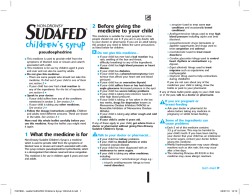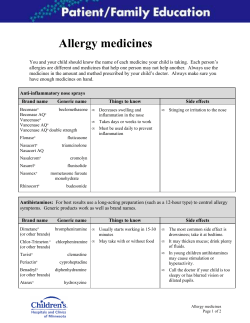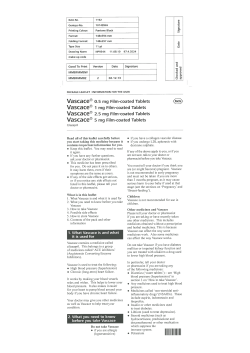
Desmopressin (DDAVP ) for bedwetting
Desmopressin (DDAVP®) for bedwetting How does this medicine work? Giving DDAVP into the nose Desmopressin (DDAVP) is a synthetic form of vasopressin hormone, a chemical made by the pituitary gland. It works on the kidneys to decrease the amount of urine made. Check that you have the correct solution of DDAVP, which has 10 mcg/spray. Do not use the more concentrated nose spray called Stimate®. It has a different purpose. DDAVP can help decrease bedwetting in children. This medicine may be used alone or with other methods to prevent bedwetting. 1. Read the patient instruction guide for DDAVP before giving it. How should I give it? DDAVP comes in nose spray and tablet forms. Your doctor, nurse, or pharmacist will explain how much desmopressin to give and how often to give it. Give it at bedtime unless otherwise ordered by your doctor. Giving DDAVP by mouth, for children who cannot swallow pills: • Crush the tablet between 2 spoons, inside a plastic bag, or in folded paper. • Mix the powder with a very small amount (about 1 teaspoon) of soft food, such as applesauce, chocolate syrup, ice cream, jelly, or yogurt. Make sure your child takes all of the mixture. Do not mix medicine into hot drinks, because the heat may destroy its effectiveness. 2. If possible, children should blow their nose to clear out any mucus before receiving DDAVP. (If your child cannot do this, bulb-suction mucus out of the nose.) 3. Before using the medicine the first time, prime it by spraying it into the air 4 times. If it has not been used for a week or more, prime it again by spraying once. 4. While holding the bottle upright, give the prescribed number of sprays. Do not tilt the bottle while administering, it may affect how much drug your child will receive. If your child’s dose is greater than 1 spray, give half the dose into each nostril. 5. Tell your child to sniff in (if able) as the medicine is sprayed into the nose. 6. Rinse the spray tip with hot water and dry with a clean cloth or tissue. Desmopressin for bedwetting Page Page 1 of 3 Are there any precautions about food or other medicines? What are the side effects? Follow the directions for using this medicine provided by your doctor. Common You can give DDAVP with or without food. Avoid drinking liquids after the evening meal while taking DDAVP. Too much extra liquid can cause low sodium levels in the blood. Occasional Rare Check with the doctor, nurse practitioner, or pharmacist before giving any other prescription or non-prescription medicines, herbs, or vitamins. What should I do if a dose is missed? If a dose is missed and your child is already sleeping, you can skip the dose and continue the following night with the usual schedule. Do not give it during the day, unless ordered by your doctor. Never give a double dose. If you have questions on how to give a missed dose, call your doctor or your pharmacist. • • fluid retention redness and warmth in face • • • • • runny or stuffy nose headache nausea (upset stomach) dizziness faster heart rate • slight increase or decrease in blood pressure blood clots in undesired areas seizure • • When should I call the clinic? • headaches or other pain not relieved by acetaminophen (such as Tylenol ) irritation or bleeding in the nose (if using the nose solution) faster heart rate rapid weight gain dizziness vision problems confusion seizures signs of allergic reaction: - rash or hives - wheezing - trouble breathing - call 911 ® • • • • • • • • What else do I need to know? DDAVP should not be used by any patient who has heart problems or who has ever had a blood clot. If you are using the spray, check the bottle for the number of sprays it contains. After that number of sprays, throw the bottle away (even if there is still some liquid in the bottle). The patient instruction sheet that Desmopressin for bedwetting Page 2 of 3 comes with it tells you how to keep track of the number of sprays. Questions? Check with your doctor before stopping this medicine. This sheet is not specific to your child but provides general information. If you have any questions, please call the doctor or pharmacist. You and your child should know the names of all the medicines he or she is taking. Share this information with anyone involved in your child’s care. Before giving the first dose, read the label. Be sure it is what was prescribed. After a refill, if the medicine looks different to you, ask your pharmacist about it before giving it. Check the label and expiration date before giving each dose. Ask your pharmacist what to do with outdated or unused medicines. If there is no “take-back” program empty them into the trash. . Store all medicines in their original container and away from direct sunlight or heat. Do not store in humid places such as the bathroom. Keep them out of children’s reach, locked up if possible. Store the nose spray form in the refrigerator, as far from children’s reach as possible. For more reading material about this and other health topics, please call or visit the Family Resource Center library, or visit our Web site: www.childrensmn.org. Children’s Hospitals and Clinics of Minnesota Patient/Family Education 2525 Chicago Avenue South Minneapolis, MN 55404 8/09 Copyright If too much or the wrong kind of medicine is taken, call the Poison Control Center (tollfree 1-800-222-1222). If your child is unconscious or has a seizure, call 911. Desmopressin for bedwetting Page 3 of 3
© Copyright 2025


















